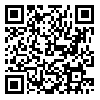دوره 8، شماره 2 - ( 3-1403 )
جلد 8 شماره 2 صفحات 142-133 |
برگشت به فهرست نسخه ها
Download citation:
BibTeX | RIS | EndNote | Medlars | ProCite | Reference Manager | RefWorks
Send citation to:



BibTeX | RIS | EndNote | Medlars | ProCite | Reference Manager | RefWorks
Send citation to:
Rashidpour P, raadabadi M, Alavi Z S, Keshmiri F. Program Evaluation of the Clinical Education Based on Four-Component Instructional Design (4C/ID) Model. EBHPME 2024; 8 (2) :133-142
URL: http://jebhpme.ssu.ac.ir/article-1-495-fa.html
URL: http://jebhpme.ssu.ac.ir/article-1-495-fa.html
Program Evaluation of the Clinical Education Based on Four-Component Instructional Design (4C/ID) Model. 1. 1403; 8 (2) :133-142
چکیده: (793 مشاهده)
Background: Clinical education is a key step in medical education. The study aimed to evaluate clinical education in undergraduate medical education programs based on the Four-Component Instructional Design (4C/ID) model.
Methods: The cross-sectional study was conducted at Shahid Sadoughi University of Medical Sciences in 2023-2024. Fifteen departments where medical students studied the clerkship and internship courses were evaluated. An evaluation checklist was used including four domains, 23 questions, and 100 items. The evaluation was implemented in three steps including "Preparation of evaluation", "Execution of evaluation" and "Preparation of evaluation report and application of results". Data were analyzed using descriptive tests (mean, standard deviation, SD, and frequency).
Results: The findings showed that the status of the departments in the "educational goals and learning tasks" domain in the clerkship and internship courses were 48.33 and 49.26, which achieved the highest level of compliance. The lowest compliance reported in the domain of "practice opportunities" was 14.30 and 15.77 in the clerkship and internship courses. The compliance in the domain of "procedural information in educational events" in the clerkship courses was 33.15 and in the internship courses was 36.17 and in the domain of "supportive information" in the clerkship courses was 24.36 and internship was 23.46, indicating a medium to a low level of compliance.
Conclusion: Clinical learning is recognized as a complex learning, which requires supportive information and practice opportunities for learning. The results showed that lower compliance was reported in the domains of "practice opportunities" and "supportive information" in the educational department clerkship and internships. Therefore, it is recommended to plan for the development of support resources on various platforms. It also requires an appropriate educational design to deliver practice opportunities in simulation and workplace environments in undergraduate medical education.
Methods: The cross-sectional study was conducted at Shahid Sadoughi University of Medical Sciences in 2023-2024. Fifteen departments where medical students studied the clerkship and internship courses were evaluated. An evaluation checklist was used including four domains, 23 questions, and 100 items. The evaluation was implemented in three steps including "Preparation of evaluation", "Execution of evaluation" and "Preparation of evaluation report and application of results". Data were analyzed using descriptive tests (mean, standard deviation, SD, and frequency).
Results: The findings showed that the status of the departments in the "educational goals and learning tasks" domain in the clerkship and internship courses were 48.33 and 49.26, which achieved the highest level of compliance. The lowest compliance reported in the domain of "practice opportunities" was 14.30 and 15.77 in the clerkship and internship courses. The compliance in the domain of "procedural information in educational events" in the clerkship courses was 33.15 and in the internship courses was 36.17 and in the domain of "supportive information" in the clerkship courses was 24.36 and internship was 23.46, indicating a medium to a low level of compliance.
Conclusion: Clinical learning is recognized as a complex learning, which requires supportive information and practice opportunities for learning. The results showed that lower compliance was reported in the domains of "practice opportunities" and "supportive information" in the educational department clerkship and internships. Therefore, it is recommended to plan for the development of support resources on various platforms. It also requires an appropriate educational design to deliver practice opportunities in simulation and workplace environments in undergraduate medical education.
| بازنشر اطلاعات | |
 |
این مقاله تحت شرایط Creative Commons Attribution-NonCommercial 4.0 International License قابل بازنشر است. |




